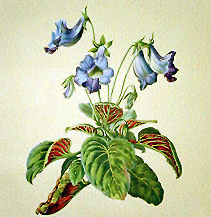Sinningia speciosa
| Sinningia speciosa | |
|---|---|
 | |
| Scientific classification | |
| Kingdom: | Plantae |
| (unranked): | Angiosperms |
| (unranked): | Eudicots |
| (unranked): | Asterids |
| Order: | Lamiales |
| Family: | Gesneriaceae |
| Genus: | Sinningia |
| Species: | S. speciosa |
| Binomial name | |
| Sinningia speciosa Baill. | |
Sinningia speciosa, commonly known in the horticultural trade as Gloxinia, is a tuberous member of the flowering plant family Gesneriaceae. The common name has persisted since its original introduction to cultivation from Brazil in 1817 as Gloxinia speciosa. The name florist's gloxinia is sometimes used to distinguish it from the rhizomatous species now included in the genus Gloxinia. Another common name is Brazilian gloxinia.[1] The plants produce large, velvety, brightly colored flowers and are popular houseplants. Cultural requirements are similar to those of African violets except that S. speciosa generally requires more light and often has a dormant period, when the tuber should be kept cool and dry until it resprouts.
Cultivation
While generally grown indoors, its hardiness is zones 10-12.[2]
References
- ↑ "Sinningia speciosa". Natural Resources Conservation Service PLANTS Database. USDA. Retrieved 16 November 2015.
- ↑ SFGate: How to Propagate Gloxinia